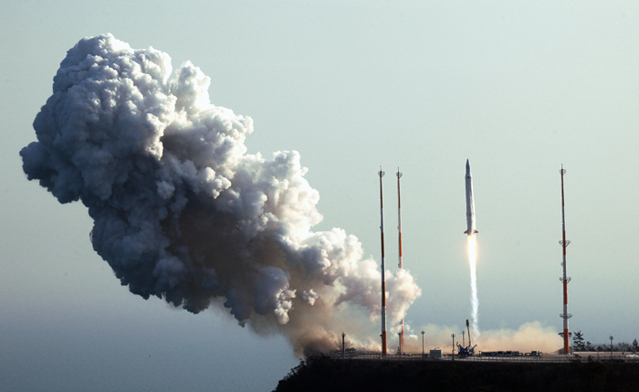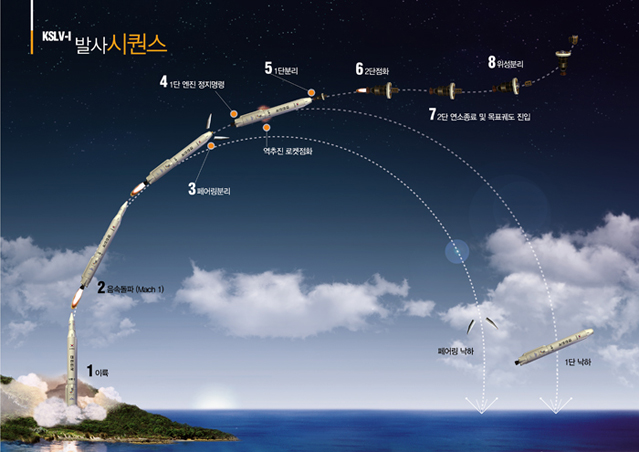South Korea
launches rocket into orbit
31 January 2013
South Korea succeeded in launching a space
rocket for the first time on its third attempt.
Seeing eleven years of effort pay off, the Naro
rocket reached a target altitude nine minutes
after takeoff and placed a satellite in orbit,
said the Ministry of Education, Science and
Technology on Wednesday, January 30.
The government also confirmed that a satellite
research center at the Korea Advanced Institute
of Science and Technology
(KAIST) in Daejeon received a signal from
the satellite at 3:28 a.m. the next day and it
is fully operational.
The Naro, also known as the Korea Space Launch
Vehicle-1 (KSLV-1), was launched from Naro Space
Center located in the southwestern region of the
peninsula at 4 p.m. on Wednesday. The blastoff
was so strong that vibrations and noise were
felt at the press center five kilometers from
the launch pad.
 Korea’s
first successful rocket launch takes place
at Naro Space Center in Goheung, Jeollanamdo
(South Jeolla Province) at 4 p.m. on January
30 (photo courtesy of KARI).
Korea’s
first successful rocket launch takes place
at Naro Space Center in Goheung, Jeollanamdo
(South Jeolla Province) at 4 p.m. on January
30 (photo courtesy of KARI).
The shields covering the satellite payload
located on the top of the rocket successfully
separated 215 seconds after blastoff at an
altitude of 177 kilometers. After 232 seconds,
the first-stage rocket finished its duty and was
retired. After 395 seconds, the second-stage
entered the target orbit.
When the announcement that the satellite had
successfully separated from the second-stage
rocket was made at 4:09 p.m., everyone cheered
at the Naro Space Center in Goheung,
Jeollanam-do (South Jeolla Province). At 5:26
p.m., KAIST confirmed that a ground station in
Norway had received a beacon signal for ten
minutes from the separated satellite, meaning it
is right on the target orbit.
At 3:27 a.m. on January 31, the satellite
research center at KAIST announced that it
received a signal from the satellite, and
received a beacon signal for 14 minutes 58
seconds starting at 3:28 a.m.

Naro soars into the sky after blasting off
from Naro Space Center (photo courtesy of
KARI).
After the first communication, it communicated
with the satellite for the second time at 5:11
a.m., meaning the entire mission from the rocket
launch to satellite operation had been a
success.
The successful launch transformed Korea into a
space power, a meaningful outcome because Korea
was a late-comer in space development.
“We were late to start space development,” said
Lee Sang-ryul, a director of satellite research
and development of the Korea Aerospace Research
Institute (KARI). “We started from scratch 20 to
25 years ago and continued with determination to
overcome any obstacles.”
Korea tried to send the same rocket into the
orbit in 2009 and 2010 but to no avail. The
government laid out a plan to launch Naro in
2002 and two years later it signed a contract
with Russia to help develop the rocket. Under
the contract, Russia provided the first-stage
booster rocket and system operation technology
while Korea developed the second-stage rocket.
 Naro
launches (1) and breaks the sound barrier
(2) before the shields are separated. The
first-stage booster is separated (5), the
second-stage rocket is ignited (6), and the
satellite is separated (photo courtesy of
KARI).
Naro
launches (1) and breaks the sound barrier
(2) before the shields are separated. The
first-stage booster is separated (5), the
second-stage rocket is ignited (6), and the
satellite is separated (photo courtesy of
KARI).
In August 2009, the rocket failed to put its
satellite in orbit due to the failure of one of
its two shields covering the satellite to
separate. In June 2010, a rocket carrying
another satellite exploded two minutes into its
flight.
“Experience counts most,” Lee said, addressing
the success after two failed attempts. “Tens of
thousands of components should work precisely.
The past attempts failed but they were only a
part of preparation. Other countries have walked
similar paths.”
According to the ministry, South Korea has
become the eleventh nation in the world to a
rocket into space from its own soil.
“Although we started late, we learned a lot in
launching space rockets and managing the
system,” said Minister Lee Joo-ho.
Now the satellite is in an elliptical orbit 300
kilometers above the Earth at the nearest and
1,500 kilometers at the farthest. The satellite
weighs 100 kilograms and makes one revolution
around the earth every 103 minutes, or 14 times
a day. It is programmed to check whether it is
on the right trajectory, do scientific
observations, and test new technologies.
 Children
wearing Naro hats cheer for the launch of
the rocket at Gwacheon National Science
Museum in Gyeonggi-do (Gyeonggi Province) on
January 30 (photo: Yonhap News).
Children
wearing Naro hats cheer for the launch of
the rocket at Gwacheon National Science
Museum in Gyeonggi-do (Gyeonggi Province) on
January 30 (photo: Yonhap News).
Regardless of the Naro space program, South
Korea has been working to develop its own rocket
with a 260-ton thrust, which consists of four
75-ton engines, to be completed around 2021.
Korea depended on Russian technology for Naro’s
booster rocket and engine.
“We gained confidence from the success,” said
Lee Sang-ryul. “Korea’s indigenous booster
rocket -- when it is developed -- will go
through a process similar to Naro development.”
KARI intends to send multipurpose and science
satellites into orbit one after another and to
launch a mission to the moon in 2023 and a
landing craft to the natural satellite in 2025.
Korea launched its first satellite Uribyol-1
(KITSAT-1) in 1992, followed by broadcasting and
telecommunication satellite Mugunghwa-1
(KOREASAT-1) in 1995, multipurpose satellite
Arirang-1(KOMPSAT-1) in 1999, and Arirang-2 and
Mugunghwa-5 in 2006, among others.
By Limb Jae-un